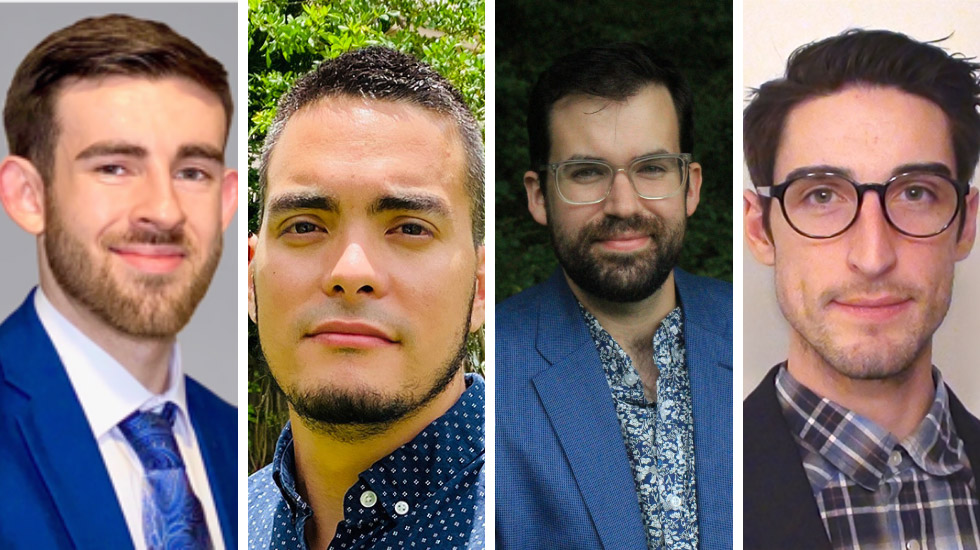
Left to right: Jacob Gorton, Richard Hernandez, Alex Wheeler, and Daniel Rutstrom
Three nuclear engineering doctoral students—Jacob Gorton, Richard Hernandez, and Alex Wheeler, along with materials science engineering doctoral student Daniel Rutstrom—recently received the 2020 Innovations in Nuclear Technology R&D Award for their research.
Gorton’s research focuses on the nuclear reactor and safety performance of a unique fuel form that consists of a mixture of thorium mononitride (ThN) and uranium mononitride (UN). The novel fuel type may provide enhanced accident tolerance and safety benefits compared with traditional uranium dioxide (UO2) fuel in a pressurized water reactor (PWR), the most common type of commercial power reactor in the US.
“I am extremely humbled to have received this type of recognition in an area of research that I am so passionate about,” said Gorton. “My graduate career has been focused on evaluating advanced nuclear materials, and it has all been made possible by the connections I have made at both the University of Tennessee and Oak Ridge National Laboratory.”
Hernandez received the award for his work in coupling neutronics and thermal hydraulics design. These are useful for developing non-nuclear borated heater rodlets for critical heat flux (CHF) experimentation.
The goal is to experimentally study the effects of surface oxidation, radiation-induced surface activation (RISA), and the effects of the thermal time constant of the rodlet material thermophysical properties on the manifestation of the CHF phenomenon.
“This award is very meaningful to me because it shows the true value of the work that I have been lucky to be a part of for the last two years,” said Hernandez. “I hope that the research work that has been done here serves as the gateway towards developing a better understanding of the CHF phenomenon, and testing of advanced fuel and cladding systems to continue to ensure the safe operation of current and future commercial light water reactor designs.”
Alex Wheeler’s research is on Molten Salt Reactors (MSRs), which are a type of next-generation reactor. MSR designs have seen a tremendous increase in interest over recent years for their unique design features.
Instead of solid fuel rods, the fuel in MSRs is mixed in molten salt, which provides higher fuel utilization and increased safety benefits. However, since most non-proliferation safeguards are designed for solid fuel reactors, these innovative designs cannot be deployed worldwide.
Specifically, his research looks at what signature in the reactor’s dynamic behavior can be seen if someone were to remove plutonium and if these signatures can be measured without disrupting the plant’s operation
“The work that I and my advisor, Dr. Ondrej Chvala, are doing here at UT will help provide new signatures that can be monitored and used for safeguards,” said Wheeler. “It’s a great honor to be receiving this award. I believe this work has great potential to do good, and any recognition it earns is of great help.”
Daniel Rutstrom’s research focuses on discovery and development of new materials for radiation detection applications, with an emphasis on developing scintillators that offer better detection capabilities than existing detectors. This will allow radiological materials to be identified more effectively and efficiently, especially for the purposes of nonproliferation.
Rutstrom’s work consists of optimizing crystal growth parameters using the vertical Bridgman technique and improving performance through various compositional engineering strategies. The goal is to achieve an energy resolution less than three percent (at 662 keV) while being able to fabricate large size single crystal detectors (greater than one inch in diameter).
“Since no single scintillator meets all the necessary criteria for every application, it is worthwhile to continue exploring novel materials that could compete with or eventually replace existing technology,” said Rutstrom.